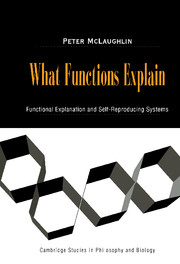10 - What Functions Explain
Published online by Cambridge University Press: 12 August 2009
Summary
It is now time to pull together the various threads of the exposition and to correlate the results of the three somewhat disparate parts of this study.
Part I, including the Introduction, attempted to clarify the problems involved in attributing a nonintentional purposiveness to natural objects.
Chapter 2 analyzed the traditional problem of teleology. First, three different aspects of the notion of teleology were sketched: (a) the distinction between relative and intrinsic purposiveness (τò oὗ and τò ᾧ), (b) the distinction between final and formal causes, and (c) the distinction between intentional and holistic causation as well as the different kinds of underdetermination of a system by the properties of its parts involved in the two cases. Intentionalism (or mechanism) copes with the underdetermination of the origin of a system by postulating the representation of the whole in the mind of an intentional agent, thus making the origin of the system completely determined by embracing intentionality. Holism copes with the underdetermination of the working of a system by postulating the causal influence of the whole on the properties of its parts. In a second step, in an analysis of the main discussion of teleology (teleonomic and teleomatic processes) in modern biology, it was shown that here the basic issue lies in the kind of assumptions that have to be made in order to view the processes that produce structural or behavioral traits as completely determined.
- Type
- Chapter
- Information
- What Functions ExplainFunctional Explanation and Self-Reproducing Systems, pp. 205 - 214Publisher: Cambridge University PressPrint publication year: 2000
- 13
- Cited by



